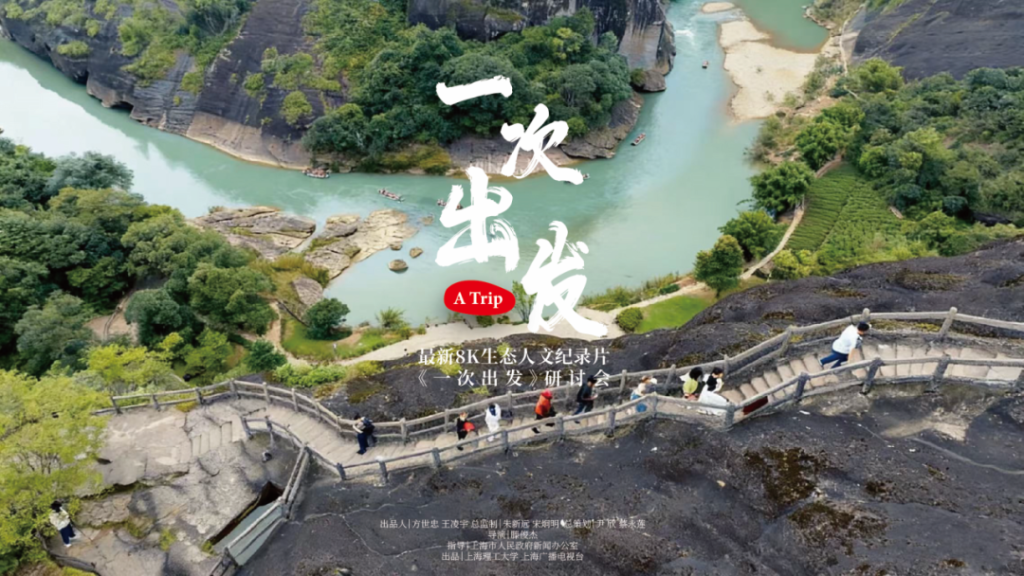

Gu Ying, a wildlife photographer and documentary director, once stood in an Antarctic snowstorm for 18 days and witnessed the difficult reproduction of emperor penguins. She also squatted in the Arctic at -40°C for more than half a month, waiting for the moment when a polar bear mother and her son climbed out of the snow cave. ; She stayed in Hoh Xil for 6 years. She was the only photographer in the world who was invited to apply for World Heritage in Hoh Xil and the chief director of the documentary "National Park Miracle"; before becoming a professional photographer, she won the National Paragliding Award four times. Women's champion national team athlete.
Gu Ying does not meet any secular definition of a young woman. She speaks for wild animals with extreme love and personal actions. She also uses the most plain tone to tell the thrilling adventure journey that is difficult for ordinary people to understand.
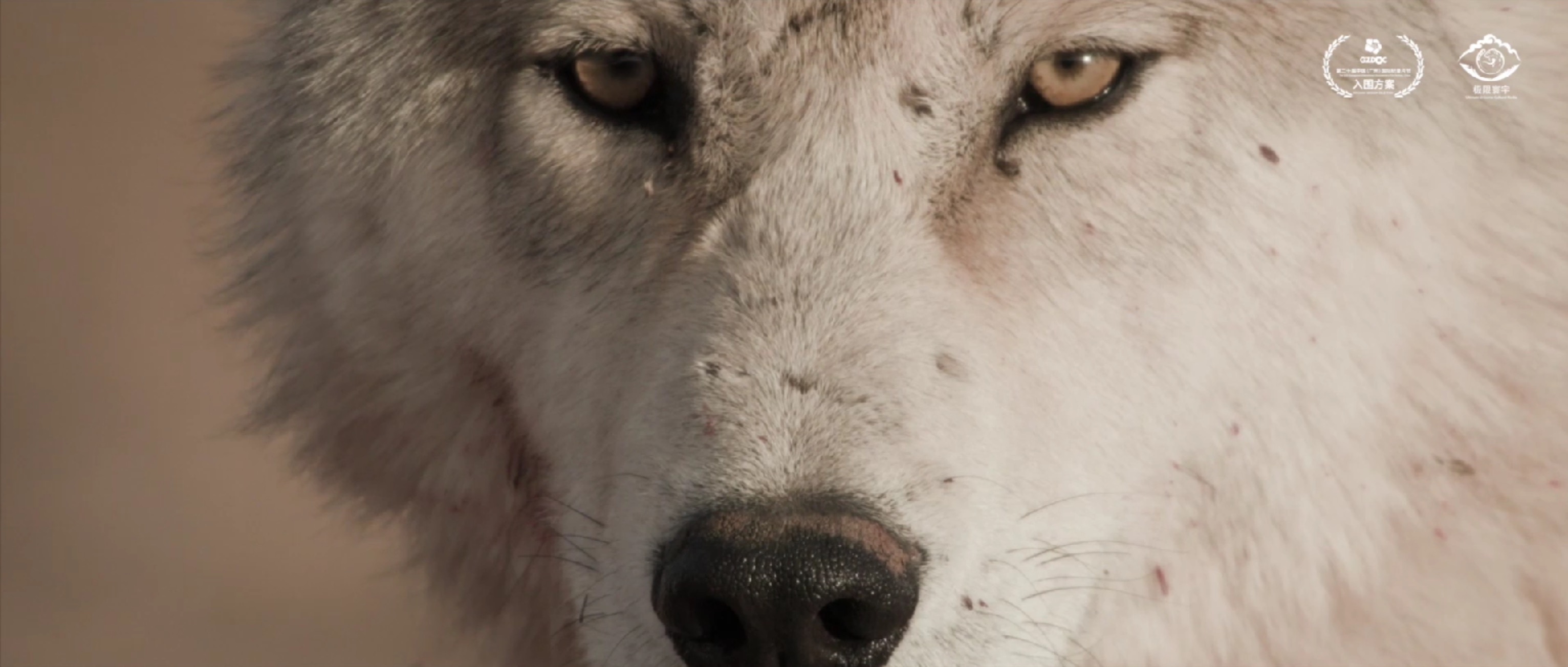
Screenshot of "Miracle of National Parks"
In early December 2023, Gu Ying's team came to the Guangzhou International Documentary Festival for the first time with a huge proposal "The Miracle of National Parks". Their proposal application funding was the most expensive among the 2023 proposals, US$1.1 million, which is almost the equivalent of Ten times that of others. The project is currently filming 49 national park candidate areas (including 5 officially established national parks), covering 28 provinces, and the subjects are more than 5,000 wild vertebrates and more than 29,000 higher plant species. There are four or five episodes per season, with each episode focusing on a national park, with each national park using its representative animals as the main story.
In an exclusive interview with The Paper, Gu Ying lamented that nature documentaries are indeed an unprofitable project, but their scarcity is self-evident.
As early as 2016, Gu Ying's "Life in the Corner - Living in the Three Poles of the Earth" series of works was quite shocking and won the Jury Award of the 2016 China Pingyao International Photography Exhibition. Gu Ying used her camera to record the living conditions of polar bears, emperor penguins in Antarctica, and Tibetan antelopes on the Qinghai-Tibet Plateau, three species that live in the three poles of the earth.
The images show both beauty and the cruelty of existence. A little emperor penguin struggled to raise its wings in the wind and snow. The chick, which had lost the protection of its parents, left in the wind and snow 2 minutes after shooting; the Tibetan antelope was injured by a car during migration, but its wet eyes were still telling the story of life. desire, but it also died on the third day after filming; and the polar bear mother and child in the wind and snow...
During the filming process, Gu Ying felt sad when she saw her reflection reflected in the eyes of the Tibetan antelope. Do you want to take a photo? Finally, she raised the camera and said, "I want everyone to see the helpless look before it died. I hope that in the future, whether it is on the Qinghai-Tibet Plateau or in our city, when we drive, if we see When animals cross the road, we should give way to them just like we do to humans. Because it is also a life."
Gu Ying was born in an Air Force family and has a deep yearning for the blue sky. When she was a child, she was stationed in the mountains with the army. Open military vehicles took the children to and from school. Gu Ying liked to stand at the back of the car and enjoy the mountain breeze and the beautiful scenery of the mountains. She also developed her bold and nature-loving character.


Gu Ying. Photo provided by interviewee
In her six-year paragliding career, Gu Ying became "the first Chinese woman to set a 100-kilometer point-to-point straight cross-country record for paragliding" and "the only pilot to land on the Minsk aircraft carrier twice with a paraglider." Behind the honor are the unpredictable airflows that we often encounter during fixed-point or cross-country flights, as well as the arduous training of landing and taking off every time.
In 2009, on the last day of training to prepare for the World Cup, a stalled fall caused Gu Ying's second lumbar vertebrae to fracture, and she had to lie in bed for three months. As for returning to the skies, the doctor said that she stopped flying for two years because paragliding requires carrying a 20-kilogram parachute bag, and her waist really couldn't bear it.
After recovering, Gu Ying went bird watching with a group of friends who loved photography. It happened to be the time when the endangered black-faced spoonbill came to Shenzhen for the winter. She used her friend's camera to take a picture of the black-faced spoonbill taking off. At that moment, she felt like she was returning to the blue sky with the flapping birds. From that day on, she began photographing birds all over the world.
In September 2011, Gu Yingyi started her own journey without any hesitation. She drove an off-road vehicle to Tibet alone for more than two months. In order to photograph rare plateau bird species such as red-breasted pheasant and brown-tailed pheasant, she waited alone in the high-altitude mountains for several weeks. I stayed in a temple every night and started climbing the mountain alone at three in the morning. I waited quietly in the jungle and cliffs all day long. I overcame altitude sickness, hunger, thirst and cold. I only ate a pack of instant noodles in the evening. Finally, I got my wish. The extremely rare red-breasted pheasant was photographed.
The Qinghai-Tibet Plateau has its own uniqueness. It is a high-altitude uninhabited land. In Gu Ying’s words, “If you don’t persevere there, you won’t be able to persevere.”
Gu Ying has traveled to the world's seven continents, four oceans and 33 provinces, municipalities, autonomous regions and special economic zones in China, photographing more than 1,000 species of birds. Her rare bird works have been included in the world's authoritative bird encyclopedia, "The Handbook of Birds of the World" ( HBW).
In 2022, Gu Ying's team participated in the first and second episodes of pure wild animals of the large-scale documentary "I Live at the Head of the River" with human and nature content. This project won the 2022 "Five One Project Award" from the Propaganda Department of the Central Committee of the Communist Party of China. .
"This is my personality. When I do something, I either don't do it, or I do it well. In fact, the energy of paragliding is the same as the state of shooting. They both require the ultimate spirit." Gu Ying said.
From photographing birds to photographing all wild animals, Gu Ying's content has attracted more and more attention. However, in her heart, being widely recognized by the industry is not enough. She often watches BBC nature documentaries and aspires to be the world's top Nature documentaries are her goal.
【dialogue】
The amount of animal material on the Qinghai-Tibet Plateau has exceeded 1,000 TB
The Paper: I watched a documentary about Tibetan foxes before and heard the director talk about the difficulty of filming on the Qinghai-Tibet Plateau.

Screenshot of "Miracle of National Parks"
Gu Ying: The Tibetan fox is a relatively easy animal to photograph on the Qinghai-Tibet Plateau, and has been photographed many times. Snow leopards are relatively difficult to photograph. Snow leopards have received a lot of attention now, and everyone is trying their best to photograph them, so there are more images of snow leopards than before. It’s not difficult to photograph a snow leopard. It’s important to tell the story of the snow leopard well. Of course, good images are also important.
Snow leopards are also our main shooting subjects. We have a lot of snow leopard content, and many of the materials are very rare. The most difficult thing about snow leopard behavior is its hunting. Only a handful of snow leopards have been successfully photographed in the world. It is normal to try and photograph a snow leopard many times but not be able to see it.
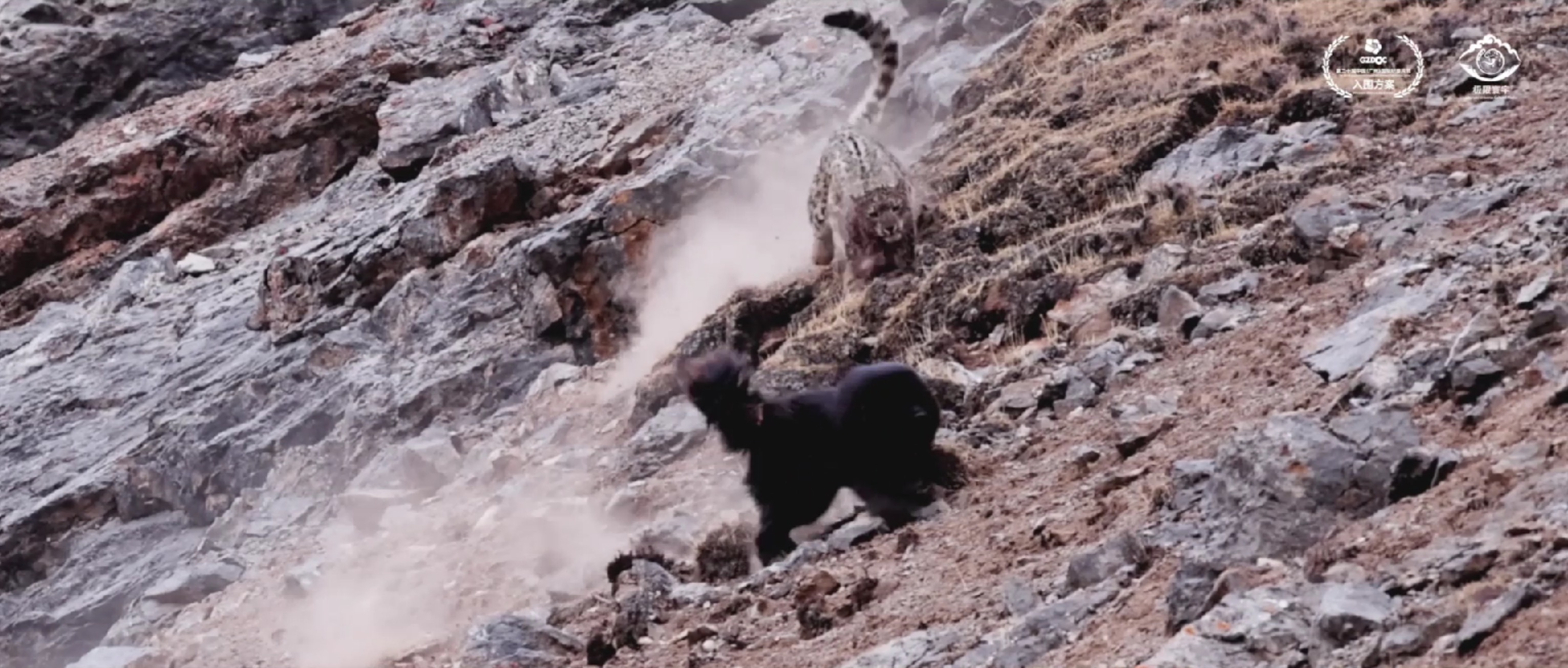
Screenshot of "Miracle of National Parks"
The Paper: Why is it difficult to photograph snow leopards hunting?
Gu Ying: It is very stealthy when hunting. You can't find it at all. The whole process of hunting is very fast, so you really need luck. Secondly, technology is also needed. When it runs in an instant, it has to chase the focus and catch it in place. When it runs, there must be no obstruction in front of it. You think, if the sheep runs quickly, it is very likely to fall from one cliff to the next, and the range is very large. A lot of uncertainty. But we were lucky enough to have photographed two predations, and the process of capturing snow leopards’ predation was very telling.
For example, when it failed at first, it tried to hunt other animals, even domestic yaks. The yaks were in a group, so the yaks united and drove it away. Then it failed again and could only think about it again. Method, because you have to survive. The survival of wild animals is very difficult, and they experience various failures every day. We will match the stories in this project. We have a rich amount of material. Our current material amount of animals on the Tibetan Plateau has exceeded 1,000 TB.
The Paper: How many people are there in the team?
Gu Ying: There are not many people who take photos there for a long time, just a few people. Because shooting wild animals is affected by the external environment, we cannot have many people. We rely on squatting for a long time.
The Paper: That’s why I had the experience of photographing a Tibetan antelope in a tent eating only eight-treasure porridge every day.
Gu Ying: Yes, that was when I was shooting in Hoh Xil. Because photographing the Tibetan antelope is different. You have to completely hide yourself to photograph it. Its natural enemies, such as brown bears, have a keen sense of smell. It will be very dangerous if they smell the smell, so you can't eat anything with smell. food. Tibetan antelopes can completely relax and wander up to you when they cannot feel your presence. Otherwise, they will run far away at the slightest movement from you. Unlike when photographing a snow leopard, it only has two states: it either ignores you or leaves because it annoys you. It generally does not attack people.
The Paper: Have you ever been attacked while photographing animals?
Gu Ying: Yes, there are hidden brown bears. Every year there are incidents of brown bears eating people. A brown bear will slap your face off.
I wasn't attacked by it at that time, it just chased me. I saw it was chasing me, do you think I can stop running? But I am a photographer, and I don’t want to lose my business. If I don’t have a camera, won’t I be able to take the photo? I was still running with the equipment on my shoulder. I felt at that time that I had to take pictures. I was panicking and scared when I saw it chasing me. I fell to the ground. I couldn’t move after it fell to the ground. It was still chasing me. We recently Only a few meters away...
That was a few years ago. That time was actually my problem. When I was standing in its territory, it got angry and attacked me. Normally, wild animals don’t attack people actively. Only they feel threatened. Only then will they attack people.

Screenshot of "Miracle of National Parks"
Front-line photographers are needed to constantly supplement real materials
The Paper: Do you have a team of experts following you?
Gu Ying: There must be a team of experts. If we have any scientific questions during the whole process, we will consult experts. To be honest, some experts who study snow leopards find it difficult to see snow leopards. Therefore, experts were very excited to get these clips back. Many of the behaviors we captured have never been heard of by experts. For example, we have photographed snow leopards climbing trees. Golden leopards should be able to climb trees. At that time, we had never heard of snow leopards climbing trees. We have photographed them, and it was the snow leopard mother who taught the little snow leopards to practice climbing trees.
The Paper: What is the focus of the team’s filming now? How far along is the filming in the national park?
Gu Ying: We mainly photograph important species in this region, and we must also photograph biodiversity. What you want to tell is an ecosystem, which is never-ending. We have now photographed 5 national parks, 4 of which are in Qinghai, and 1 is the Hainan Tropical Rainforest National Park, which is also one of the 5 announced national parks. The second episode of "China's Hainan·Rainforest Secret" to be broadcast by CCTV 9 at the end of 2023, "The Symbiosis of All Things", was co-produced by us. This is the first time that a documentary tells a long story about the only 37 Hainan gibbons in the world. The story of survival, the species is very rare, the images are very precious, and it has won widespread praise in the industry.
For our new national park project, most of the content has been filmed and will be edited as we go. We have a massive library of materials that can create different themes. "National Park Miracle" is just one of the projects we are currently working on, but this project is indeed a very big topic. We came to the Documentary Festival just to tell everyone that we have the ability to shoot this. The current materials are completely matched. We have several copywriting, which can be based on species, ecosystems, or regions. Finally, we will work with our partners Choose the final plan. There is no problem with the content, it just depends on how to tell the story and from what angle to tell it that will be more attractive. I am the director and we are a top-notch filming team.
The Paper: Nowadays, documentaries are gradually paying more attention to sound effects. Maybe when shooting animals, the sound effects are not very good, and they need to be re-foleyed.

Screenshot of "Miracle of National Parks"
Gu Ying: Yes, for example, the sounds of animals walking can be foleyed, but very unique sounds, such as the sounds of animals, are best recorded in real time. We will pay attention to these when shooting. The sound of a snow leopard is just like that of a human being. It laughs when it is happy and cries when it is sad. The sounds cannot be the same. Different behaviors have different sounds, and they all need to be recorded.
In fact, everyone has some misunderstandings. There was once an out-of-famous snow leopard meowing on the Internet, and everyone believed that snow leopards can only meow. This is not the case. Meowing is just a sound when it performs a certain behavior. But after watching an Internet celebrity video, the public believed that snow leopards can only meow. Snow leopard is such a ferocious animal, it turns out that it meows. I posted the roar of the snow leopard we captured on a certain platform, and was questioned about the error in the post-production Foley sound. In fact, some people had misunderstandings. Would you say that the sound that an animal makes to mate is the same sound that warns you? Therefore, it is even more necessary for us front-line photographers to constantly supplement this kind of real material.
Difficulties and challenges in shooting natural documentaries in China
The Paper: Nature documentaries are particularly scarce in China. What do you think is the reason?
Gu Ying: In fact, it is not particularly scarce. We have shot too many on the front line all year round, but we have done little publicity. People’s energy is limited. If you can take care of one thing, you can’t take care of the other. We are busy with publicity every day, so shooting is natural. Time is running out, so we will now try to do more publicity to let the public know more about the truly cutting-edge science. Appropriate content will also be matched according to different broadcast platforms. Domestic and foreign audiences are different, and online audiences and TV audiences are also different. The audiences are different, and you must come up with different styles for the audience.
Of course, what you ultimately express is a universal value. First of all, the science must be correct, and secondly, the story must be good. This story can ultimately arouse empathy from the audience. He can feel it from the animal and see it a bit like himself. For example, when you see a wolf nursing its child, you will be reminded of the love between mother and child.
Animals' various ways of living include not only their cute side, but also their strong and challenging side. Drama and conflict are a must. In fact, you will have them when you are filming. For example, when I photographed a fox stealing a bird's egg, the mother bird would resist. For another example, if a wolf goes to catch a lamb, you will see the mother sheep looking helpless from a distance, but the next second, after the wolf has finished eating, he returns to his den to regurgitate the cud to feed his little wolf. Only then will you realize Yes, the wolf is also a mother, so there is no one who is bad or good in nature, they are all just for survival.
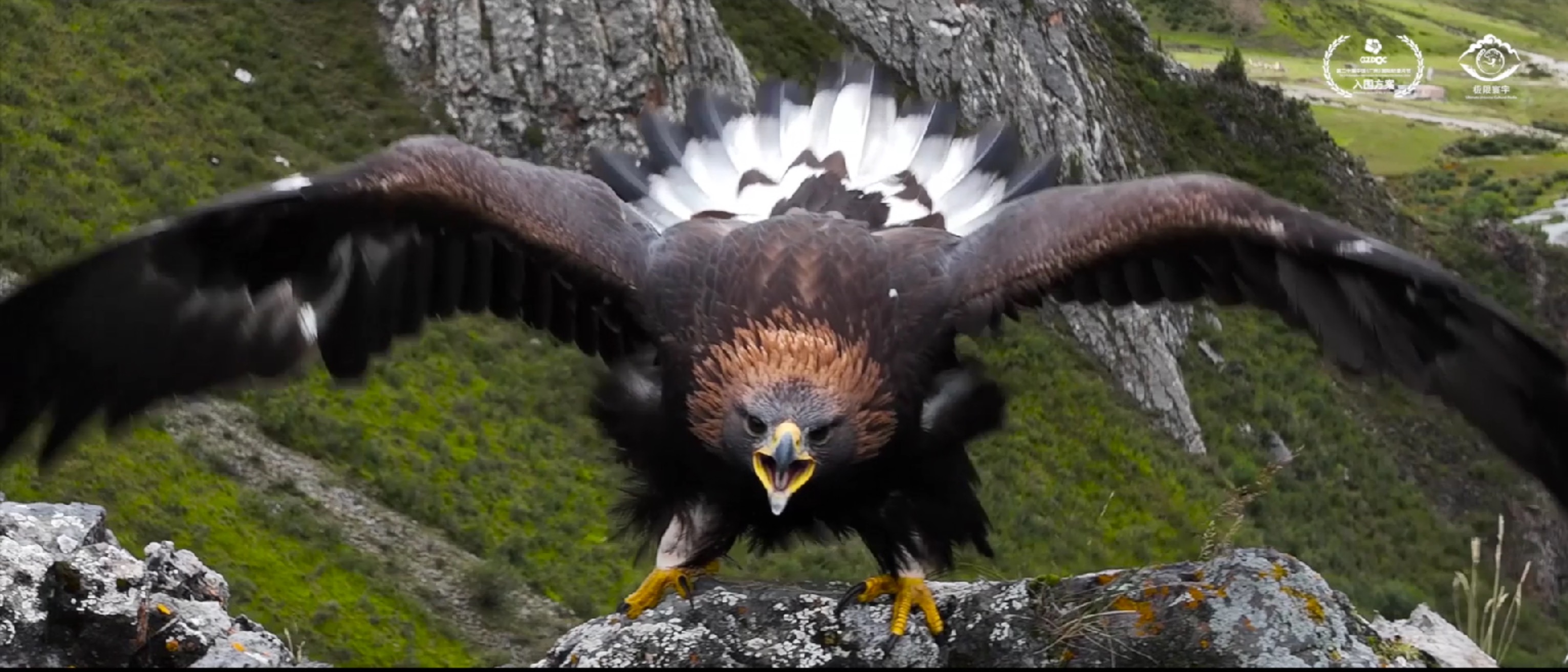
Screenshot of "Miracle of National Parks"
The Paper: Did you encounter any animals in need of rescue while filming?
Gu Ying: Unless it is caused by human intervention, such as an injury caused by human factors, such as a Tibetan antelope being hit by a car while crossing the road, it must be rescued. If under normal circumstances, like what I just told you, it happens naturally, generally let it take its course.
The Paper: Will young people join the team for such a difficult shooting?
Gu Ying: It’s not that young people can’t endure hardship, but they may not love it to that extent yet. You don't make money doing this. Young people are still in a hard-working stage, and they are under great pressure to survive and need to support themselves. If you are too young to do it, you will need to have no pressure to survive and love it very much. If you don't love it to the point of selflessness, to be honest, it will be quite difficult to keep going. You will give up halfway for various reasons, because if you use this energy If you do other things, the financial returns may be greater than this.
So it has nothing to do with whether you are young or not, it has something to do with the person's own state. Everyone in my team is the same as me. They all love this matter from the bottom of their hearts. The state is their own, not forced on them, so we can come together. Another point is that nature content is still a niche subject after all, and there are indeed relatively few people doing it.

Screenshot of "Miracle of National Parks"
The Paper: If we go to Station B to watch, nature documentaries are still high on the list.
Gu Ying: The volume is still small, not as numerous as other genres, so it will be obvious if an excellent film is produced. Large-scale nature documentaries require a lot of investment, may be compared to several other films, and take a long time. There are also issues with broadcast channels. Maybe our Tibetan-themed content will be more popular abroad than at home. , because things are rare and valuable.
The Paper: The co-producer is the producer of "The Rise of the Monkey King"?
Gu Ying: Hui Ting is the producer of a nature film we are currently working on. This film is also related to the Qinghai-Tibet Plateau. The first version has been cut and the name has not yet been finalized. It will be released in theaters.
The Paper: What is the hardest part right now?
Gu Ying: The most difficult thing is financing. 2023 may be more difficult. Of course, this does not interrupt our filming. We have not stopped filming for three years due to the epidemic, so we have so much content.
The Paper: Can’t stop?
Gu Ying: Yes, we can only move forward and cannot stop. So many things must be done, and I firmly believe that our content will be excellent. I firmly believe in this. I just need to find someone who believes in it as much as I do. people. To be honest, even if there is no financing, we will make it. Maybe if we change the logic, the content will still be these. We have a treasure trove and can make diversified things. We worked on an online platform for a year, with more than 1 million fans, and only posted 100 posts. Because we were busy making documentaries, the team stopped updating for more than half a year. In 2024, after I finish all these things, we will still Will continue to do so.
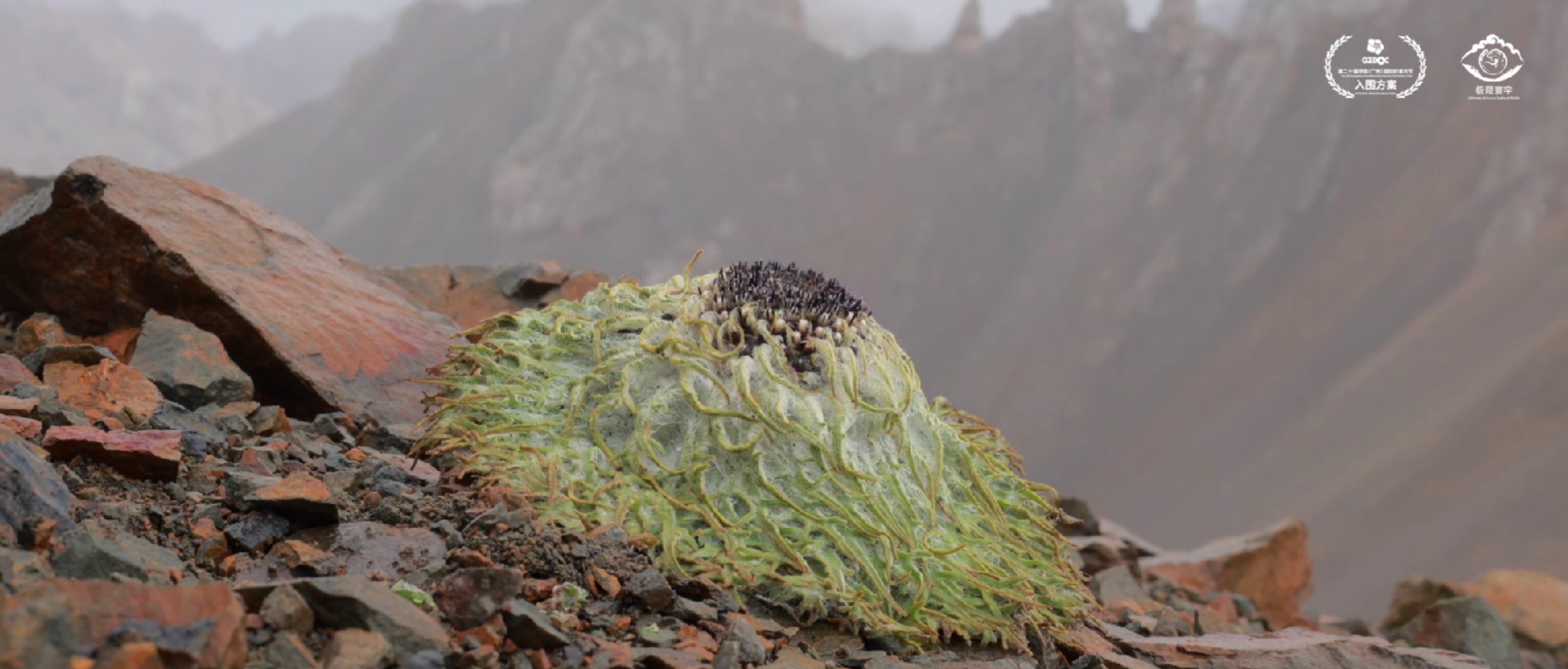
Screenshot of "Miracle of National Parks"
The Paper: Although you are in the wild all year round, you are not completely out of touch with society. This is quite surprising.
Gu Ying: The influence of society is actually quite large, but people should know how to arrange their own lives. Whether you do or not do many things is not because you don’t understand it, but because you understand it and don’t do it. That’s your decision. choose. The images we took cannot be stored on my hard drive. They deserve to be seen by everyone. This is also a way to promote the protection of nature, right? It must have been something meaningful.
The Paper: After filming for so long, has "Our Home" changed much?
Gu Ying: Everything is changing. It cannot remain the same. Everything is changing. We are all getting older, right? Isn't this normal? Some people may also ask whether the lack of photos means that there are fewer species. This is not necessarily the case. It is better to look at more scientific research. On the other hand, as more images are taken, it is not necessary to say that there are more of them. There must be many changes. For example, the area of glaciers is getting smaller and smaller...

Gu Ying. Photo provided by interviewee
The Paper: One day you can no longer carry the camera, will you consider changing careers again?
Gu Ying: Now there is no need for me to carry the camera and run away. I have assistants. Of course, I will do it myself in some emergencies. So now I will train more people to join, and my more responsibilities in the future may not necessarily have to be on the front line. Because there are talents in this field, everyone can work together, and professional things must be done by professional people.
I probably won’t change careers again. I don’t know how many years I have to work on this “Miracle of National Parks”... People in any industry have their own talents, and their abilities will have a tendency. It’s impossible. They are good in all fields. I admit that there are all-around players, but such people must have been working hard in one field for many years before they can be excellent. How long can a person's life be if he invests more time and energy in this field? How many things can be done? I think happiness lies in the fact that what you do is something you like. This is very important. Only if you like it, you will get involved, and you are willing to give everything for it. If you keep doing it, I believe you will gain something.

